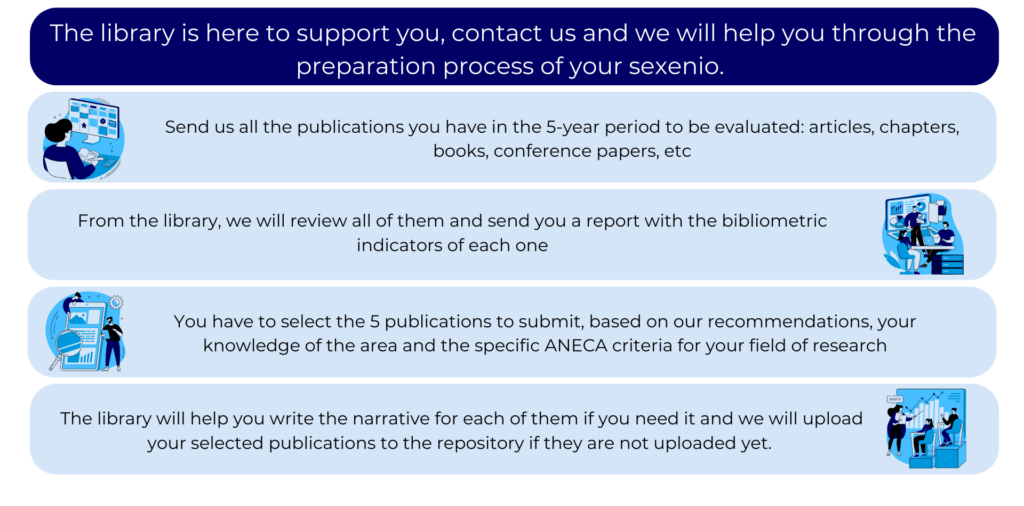RESPONSIBLE USE OF METRICS
Bibliometric indicators are quantitative metrics that allow the quality and impact of scientific results to be assessed.
To ensure a responsible use, it is essential to contextualize the indicators used, consider their limitations and complement them with other types of evidence. Indicators should be use to justify qualitative judgement on research assessment and no metric or combination of metrics should be used as a substitute for expert peer review in research performance assessment.
All metrics have weaknesses and biases. Not taking biases into account means that any interpretation or analysis will always be incomplete and can lead to lead to unwise decisions.
For more information on the responsible use of metrics and good practice in research evaluation, please visit the following websites:
ARTICLE & BOOK LEVEL METRICS
These are indicators that measure the quality of a particular article. Standardized metrics should always be preferred, as they allow comparison of different articles.
It is important to know that there are different types of citations.
Citation is a simple citations count a publication have receive. You can find this metric in Web of Science (WOS), Scopus and Google Scholar.
Nomalized Citations is an indicator of the impact of each researcher’s publications based on the number of citations received, compared to the number of citations of the world’s scientific production in the same period and subject area. Normalised impact values above one indicate that the impact of a given researcher’s publications is higher than the world average in his or her subject area in that period.
You can find different types of normalized citations:
- Highly Cited Papers (WOS): Papers from the most recent ten years, which have reached the top 1% citation threshold for their designated publication year and subject category.
- Hot papers (WOS): Papers from the most recent two years, which have reached the top 0.1% citation threshold. This indicates an exceptionally high number of citations soon after publication.
- Average number of citations per field (WOS): Citation rates by year and discipline allow the comparison of the number of citations for specific articles published in the same year and indexed in the citations for specific articles published in the same year and indexed in the same discipline.
- The Field Weigh Citation Index (Scopus): FWCI is a ratio of citations received by an article to the number expected for similar articles. It attempts to correct differences in citation norms across disciplines.
- Dimensions Field Citation Ratio (Dimensions) This metric compares the number of cites in one article to other publications in the same field and establishes an average
When using citations as an indicator of quality it is important to be aware of ther limitations:
- The number of citations may differ between databases, because they are calculated within the databases material.
- The citations are usually coming from articles and conference papers, losing the citations coming from books, book chapters and other materials.
- Citation behaviour can be different depending on the field. The same number of citations in different areas of knowledge can mean different impact.
- The same is true for different types of publications, so do not compare citations between articles and books, for example.
Altmetric indicators are measures of the impact of published research beyond traditional citations, such as the number of likes, mentions, shares, etc. an article or other research output has received. These metrics will be affected by differences in media attention across disciplines but may give a useful early indicator of attention and social impact, media interest or scholarly interest. This metric is available in Dimensions.
It is important to remember that not all alternative sources in which a paper is mentioned are indexed in these aggregators, just as it is not always possible to correctly identify mentions of a particular paper.
PlumX indicators are a count of the number of likes, mentions, shares, etc. an article or other research output (including preprints, videos, web pages, etc.) has received. This information is available on SCOPUS.
It is important to remember that not all alternative sources in which a paper is mentioned are indexed in these aggregators, just as it is not always possible to correctly identify mentions of a particular paper.
The Scholarly Published Indicators (SPI) is the main indicator for books and book chapters is the Sholar Publish Indicator. SPI is a system that provides a ranking and indicators of academic publishers.
JOURNAL LEVEL METRICS
Journal-level indicators are used to measure the impact, relevance and quality of a particular publication through the number of citations received, among other things. This indicator allows different journals to be compared with each other.
It is important to note that journal-level metrics can never be used as a unique evidence, as they do not demonstrate the quality of a scientific publication. They should always be used in conjunction with other metrics.
The Journal Citation Reports (JCR) measures the average normalized citation impact for articles published over a three-year period, grouped by subject category.
The list of journals in the same category, ordered from highest to lowest impact factor, is divided into four equal parts, each of these parts being a quartile. Similarly, by dividing the list into ten parts, the deciles are obtained. The quartile and decile in which a journal is found can be used as an indicator of quality together with the position of this journal in the ranking.
The percentile is calculated by transforming the position in the Journal’s category ranking into a percentile value, which allows for a more meaningful comparison between categories.
CiteScore is a metric that represents the average number of citations received for all articles published in that journal during the four-year period prior to the publication of the article. It can be found in Scopus.
The list of journals in the same category, ordered from highest to lowest impact factor, is divided into four equal parts, each of these parts being a quartile. Similarly, by dividing the list into ten parts, the deciles are obtained. The quartile and decile in which a journal is found can be used as an indicator of quality together with the position of this journal in the ranking.
The percentile is calculated by transforming the position in the Journal’s category ranking into a percentile value, which allows for a more meaningful comparison between categories.
Matriz de Información para el Análisis de Revistas (MIAR) is an information matrix with data from more than 100 sources, corresponding to journal directories and international indexing and abstracting databases (citation, multidisciplinary or specialised), which is elaborated with the purpose of providing useful information for the identification of scientific journals and the analysis of their dissemination.
The FECYT Quality Seal identifies those Spanish scientific publications that meet internationally recognised requirements of professionalism, as well as promoting open and inclusive science, science culture and science education. The presence of a journal on this list accredits its quality.
You can use the Visibility and Impact Classification and the search engine to locate the journals.
Scimago Journal and Country Rank (SJR) it is based on the average number of weighted citations received during that year by the papers published in that particular journal during the previous 3 years. The citations are weighted using an algorithm which gives more weight to citations from more influential journals.
The list of journals in the same category, ordered from highest to lowest impact factor, is divided into four equal parts, each of these parts being a quartile. Similarly, by dividing the list into ten parts, the deciles are obtained. The quartile and decile in which a journal is found can be used as an indicator of quality together with the position of this journal in the ranking.
AUTHOR LEVEL METRICS
Personal metrics measure the impact of an individual researcher using quantitative metrics based on citations.
The h-index expresses the number of articles (h) that have received at least h citations. The h-index is influenced both by quantity (Scholarly Output) and publication impact (Citation Count). Some databases have their own h-index, such as Scopus, Web of Science or Google Scholar.
It is important to note that for this index to be calculated correctly, it is necessary that the researcher’s profile is up to date, see also our information on researcher profiles and standardized signatures.
LIBRARY SUPPORT FOR SEXENIOS
Through the National Commission for the Evaluation of Research Activity (CNEAI), ANECA carries out the evaluation of the research activity of university researchers with the aim of contributing to the promotion of the quality of the Spanish university system within the framework of the criteria and guidelines for quality assurance in the European Higher Education Area and the design of a teaching and research career model for academic researchers.


